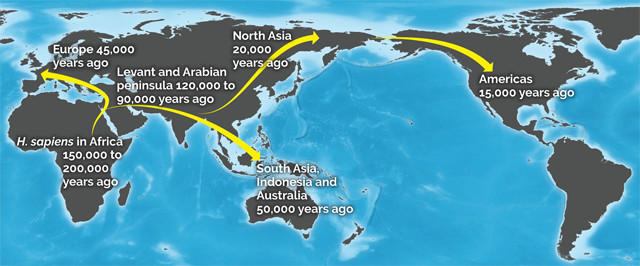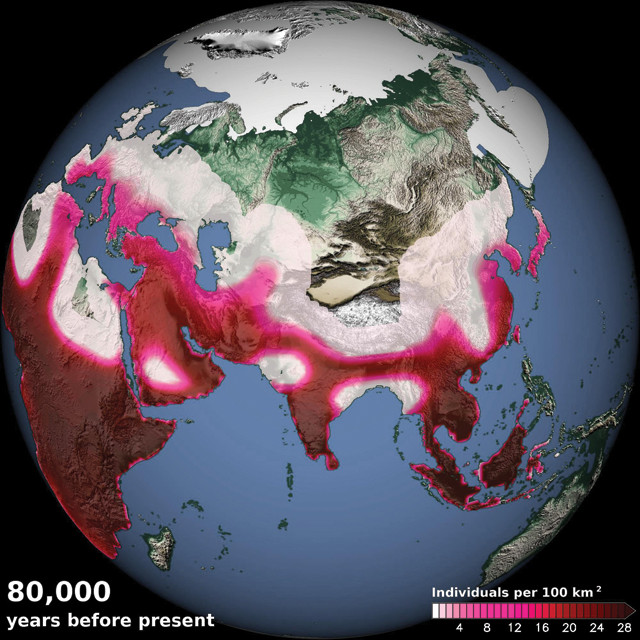
by Mary Caperton Morton Tuesday, December 20, 2016

Climate and vegetation changes over the past 120,000 years affected human dispersal out of Africa. Credit: K. Cantner, AGI, after Peter de Menocal and Chris Stringer, 2016
A trail of fossil, archaeological and genetic clues suggests that modern humans, who first evolved in East Africa about 200,000 years ago, may have made forays outside Africa via the eastern Mediterranean and the Arabian Peninsula as early as 120,000 years ago. But most fossil and archaeological evidence suggests they didn’t begin widely populating the rest of the world until about 60,000 years ago.
“This has been a big question for decades: What took us so long to expand out of Africa?” says Axel Timmermann, a climate scientist at the University of Hawaii at Manoa. In a new study that charts the time frames when climate may have been changing and influencing human migrations, Timmermann and his co-author, Tobias Friedrich, also at the University of Hawaii, offer what may be the clearest answer to this question yet: Humans were waiting for green, resource-rich corridors to open up through the deserts of North Africa and Arabia.
Scientists have long suspected that climate change played a crucial role in the timing and routes of migration out of Africa, but past climate models fell short of offering clear information about the early human diaspora. Timmermann and Friedrich created a model that coupled vegetation changes with climate variability — based on orbital variations, sea-level changes and atmospheric carbon dioxide levels — to investigate when and where people might have been moving starting about 125,000 years ago.

New modeling suggests humans dispersed from Africa via corridors of vegetation in the eastern Mediterranean and the Arabian Peninsula that appeared during times of favorable climate. Credit: Tobias Friedrich
“These modelers took on something pretty courageous: They simulated past climate and let the climate define how the vegetation changed over time; and then they … took it one step further and used vegetation change to come up with a model of human dispersion,” says Peter de Menocal, a climate scientist at Columbia University’s Lamont-Doherty Earth Observatory who was not involved in the new study. The model assumed that people would have moved more rapidly during times of plenty, rather than times of scarcity. “Vegetation represents resource availability, which is the engine, or energy, that is allowing people to move. If people are diffusing into an environment with no resources, the diffusion rate is much slower, whereas if they diffuse into an area that is lush and green, then they diffuse much faster,” de Menocal says.
The new model shows that increased rainfall may have sprouted savanna-like corridors of vegetation between North Africa and the Arabian Peninsula between 115,000 and 75,000 years ago. This stretch was followed by a dry period from 71,000 to 60,000 years ago, and then another wet period between 60,000 and 47,000 years ago. Those windows align well with the clues provided by the human fossil, archaeologic and genetic records, Timmermann says.
The study appears in Nature alongside three separate genetics studies that rely on analysis of DNA from rarely sequenced indigenous populations in Eurasia, Australia and Papua New Guinea to show that all non-Africans today trace their ancestry to a single pulse of migration out of Africa about 60,000 years ago.
Less than 2 percent of the genomes of non-African populations are composed of archaic DNA from a population that is now extinct. “This is consistent with the idea that there might have been an initial leakage [of population] out of Africa into Arabia about 120,000 years ago. This might represent a failed migration that mostly died out,” says de Menocal, who co-authored a commentary about Timmermann and Friedrich’s study in the same issue of Nature. Evidence for this initial foray — mostly from shards of rock produced during tool making — is sketchy, and the timing could overlap with the opening of green corridors that Timmermann and colleagues found starting about 115,000 years ago.
The genetics studies also found evidence for a population crash or bottleneck during the dry period between 70,000 and 60,000 years ago. “The genomics studies and the climate modeling study all complement each other nicely and show the advantages of using multiple lines of inquiry to address complicated questions,” de Menocal says.
The next step will be to seek out paleoclimate data from the corridors where people may have been migrating to validate the timing of the wet and dry periods proposed by Timmermann’s model, de Menocal says. However, finding evidence of wetter times in the Sahara Desert has proved difficult. “This is such a dry place, any lakes [or other paleoclimate evidence] that might have been there during the wet phases have long since dried up and blown away.”
© 2008-2021. All rights reserved. Any copying, redistribution or retransmission of any of the contents of this service without the expressed written permission of the American Geosciences Institute is expressly prohibited. Click here for all copyright requests.